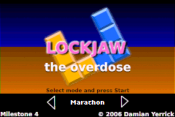From Hard Drop Tetris Wiki
|
LOCKJAW: The Overdose | |
|---|---|

| |
| Developer(s) | Damian Yerrick |
| Publisher(s) | Pin Eight |
| Release Date(s) | 2000 (PC version); 2002 (first GBA port); 2006 (latest version) |
| Platform(s) | Game Boy Advance |
|
Gameplay Info | |
| Next pieces | 3 |
| Playfield dimensions | 10w x 20h |
| Hold piece | Yes |
| Hard drop | Firm drop, roughly 250 ms delay |
| Rotation system | TOD |
| Has 180 rotation | {{{180}}} |
| Adjustable tuning | {{{tuning}}} |
| Garbage attack type | {{{garbage}}} |
| Garbage blocking type | {{{blocking}}} |
| Website | {{{website}}} |
 |

|
Lockjaw: The Overdose (abbreviated TOD) is a freeware Tetris clone for the Game Boy Advance by Damian Yerrick.
At first, the gameplay of this clone isn't anything different from other Tetris clones, especially The New Tetris. But after playing for a while, the playfield starts shaking and distorting along with the music, hence the name. It was previously known under the name Tetanus On Drugs until the release of version 4 on July 22. "Tod" is also the German word for death.
Gameplay
The rotation system of TOD, starting with milestone 4, can best be described as a mix of SRS and TGM Rotation. In free space, pieces rotate inside a bounding box like in SRS (see diagram). But if this overlaps the wall or blocks in the well, the game first tries to kick the piece's center one cell to the right, one cell to the left, and finally one cell up.
Unlike TNT, TOD uses square-by-square gravity and collision detection at all times, with less need for tactical rotation. Still, these kicks are useful for building squares:
L-spin |
|
Rotate left |
J-spin |
Slide |
Rotate left |
S-spin |
|
Rotate right |
S-spin |
First rotate |
Then rotate |
TOD uses a so-called "step recover" method to reset lock delay after a floor kick: when a piece steps down, the lock delay recharges only by the amount of time the piece would take to fall through one cell. In this system, it is possible to keep a piece alive with repeated floor kicks, albeit much more difficult than in Tetris DX.
TOD uses recursive gravity with the same "sticky" algorithm used by Tetris Blast. This allows more than 4 lines to be cleared with one piece; for this reason, the game extends the scoring table of The New Tetris, where each line is the sum of the previous two (a Fibonacci sequence):
| single | 100 points |
| double | 200 points |
| triple | 300 points |
| tetris | 500 points |
| 5 lines | 800 points |
| 6 lines | 1300 points |
| 7 lines | 2100 points |
| 8 lines | 3400 points |
| line containing a silver square | 500 points |
| line containing a gold square | 1000 points |
See also
- Tetripz, a fan game by Mute Fantasies that inspired TOD
Carbon Engine: freepuzzlearena (1999–2000) | Lockjaw: The Overdose (2000–2006)
Lockjaw Engine: Lockjaw (2006–2008+)
Other: Luminesweeper (2005) | LJ65 (2003-2009)